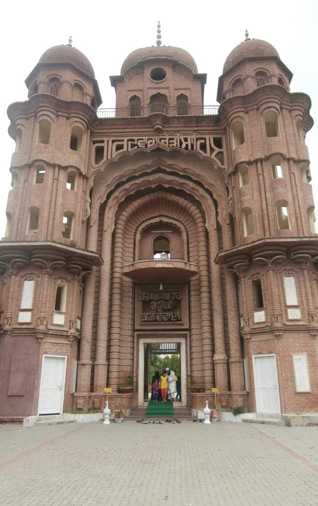Architecture
Gurdwara Rori Sahib,
Where Pebbles Became Sacred
ZAHIDA REHMAN JATT
Summers are usually very hot in the plains of central Punjab, although it rains often in the monsoon season, but as soon as it stops pouring, the heavy and overcast weather makes everyone sweat.
It was such kind of a day in early August while we were travelling to our maternal village, 65 km away from district Gujranwala, along with my maternal uncle -- ‘Maamu’ -- who is a senior advocate. As the roads leading to the village are in a very bad shape, Maamu decided to take a longer route.
Being part of the famous rice belt, the countryside of Gujranwala is very beautiful with lush and verdant fields sprawling across the landscape. The plantation of paddy plants that locals call ‘Moonji’ was in full swing, and there were men, women and children bending in knee-deep water and sowing young saplings into the fields.
After half an hour we reached Emnabad, a small town 15 km from Gujranwala. It used to be a thriving trade and agricultural market before the Partition of Punjab. It is famous for its havelis, gurdwaras and temples.
This town was once a Mayfair of Sikh festivals, especially Vaisakhi and the one held on Katak Puranmashi, in its three historically important Sikh shrines: Gurdwara Khuhi Bhai Lalo, Gurdwara Chakki Sahib and Gurdwara Rori Sahib.
It was this last one that we had had an opportunity to visit.
In order to reach it, we mistakenly chose a wrong path. It was nothing, just a small tract of mud that was dusty, full of potholes and brambles and it was a miracle that the vehicle passed through it without any mishap. However, the environment was serene, typical of the Punjabi countryside. There were some half-broken old buildings on the way that looked like ghosts from the past, decrepit and out of use.
What we eventually saw was something that was both majestic and strange if one considers the wilderness that surrounds it today. The red brick building with its imposing three chhatri-like structures was like a phantom gradually rising on the horizon and getting bigger as one approached it.
It was Rori Sahib, a gurdwara built to commemorate an event related to rori, i.e., literally, stone pebbles, and that’s how this sacred place came to be known.
According to The Encyclopedia of the Sikhs, the story of this place goes like this:
When Mughal Emperor Babar entered Punjab in 1521, the founder of the Sikh Religion, Baba Guru Nanak was present in Emnabad town and he stayed with Bhai Lalo. When the town was captured by the invading armies, they also arrested some local people. Baba Guru Nanak among them.
According to tradition, when Guru Sahib was taken prisoner, he was sitting on the rories and was busy in simran. Later, an imposing gurdwara was built on the site and was named Rori Sahib.
This Gurdwara is a large fenced structure and its entryway is a magnificent three-storied archway leading to the inner sanctum. The arched gateway is made of rust-red bricks and topped with three smaller chhatri-like domes decorated with finials.
Once inside, one can see an inverted lotus shaped-dome and a small room with circumambulatory verandah. This building is raised over the place where Guru Nanak sat at the time of his capture, although there is no roriis right now, only polished marble.
There is a large pond or sarovar on the property where people take bath when they gather here at the time of Vaisakhi. There are some more arched passageways that enhance the beauty and grandeur of the building.
A large estate and surrounding agricultural lands have been endowed to the Gurdwara from the time of Maharaja Ranjit Singh. Before Partition, there used to be weeklong celebrations of Vaisakhi and periodic congregational gatherings of Sikhs from all over the subcontinent. Although the gurdwara still hosts a large number of Sikhs at the time of Vaisakhi from across the world, its glory is somehow faded.
The empty pond and the condition of the various structures seem to echo bygone days and the past splendor in hushed voices. Soon after the Partition, the building was attacked by a mob and was set on fire, but it was reconstructed by the government and now seems to have recovered from the old wounds.
It seems true that through the virtuous touch of a pious human being even the lifeless stone pebbles can be exalted and gain a sacred status. Somewhere it becomes Hajar-e-Aswad (the black stone) and in Emnabad it becomes Rori Sahib, a Sikh Gurdwara.
Who knows the reality of things but the Creator.
* * * * *
The author is a lecturer in the Department of Anthropology and Archaeology, University of Sindh, Jamshoro, Pakistan.
[Courtesy: Academy of The Punjab in North America. Edited for sikhchic.com]
October 28, 2015



